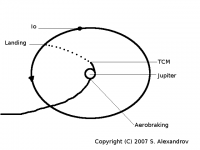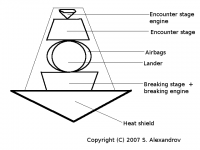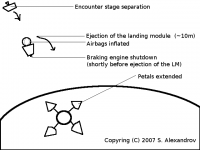Printable Version of Topic
Click here to view this topic in its original format
Unmanned Spaceflight.com _ Jupiter _ Will aerocapture work for a Jupiter orbiter/moon lander?
Posted by: Zvezdichko Feb 9 2007, 04:33 PM
This is something interesting. But knowing the harsh radiation environment of the giant, I don't know whether it could be used at all. I suppose that a plunge into the atmosphere then achieving a trajectory which leads to a direct encounter with a moon could be used for a lander... Or for a long-living orbiter.
Posted by: JRehling Feb 9 2007, 05:42 PM
Radiation should not be a problem: The harm that radiation does is integrated over time, and a quick pass through Jupiter's radiation belts on a single pass would only accumulate a small fraction of the radiation damage that Galileo encountered. The Galileo Entry Probe passed, obviously, through all of Jupiter's radiation belts once with no harmful effects. An aerocapture craft would simply do so twice. The question would be how much more radiation it had to absorb during the rest of its mission. The first few hours wouldn't be the concern.
The idea of a lander for Io or Europa that utilized aerobraking is quite interesting. Ideally, the craft would leave Jupiter's atmosphere with just enough velocity to kiss the orbit of the target moon. Then a powered descent would have similar delta-v requirements to that for a lander headed towards Earth's Moon. Some combination between powered descent and a penetrator could also be apt. In one ideal design, you could have a craft ride ballistically all the way from launch to penetration into the surface of Europa -- I wonder if the specs would work out on that?
Note that the minimum-energy departure from Jupiter would mean a slower pass through the radiation belts, and then the accumulated radiation exposure could be significant. A trajectory to "kiss" Europa's orbit would take a significant amount of radiation on the way out, versus a lot less on the speedy path in. Europa might even be, unluckily, at about the worst-case-scenario distance for radiation exposure on the post-aerobraking trajectory.
You'd definitely hope to get two-for-one value out of the radiation and entry shields. I don't know about the engineering constraints there, but if you could have a heavy metal providing heat shielding as well as protection against charged particles, that would leave a lot more mass for payload.
Posted by: Zvezdichko Feb 9 2007, 06:04 PM
Images attached. I'm not good at image design, but you should understand the basic concept of such lander...
Posted by: tty Feb 9 2007, 08:09 PM
That shield looks a lot like the massive copper heat-shield used by early Atlas missiles before ablative shields were developed. Is that a coincidence?
Posted by: Zvezdichko Feb 9 2007, 08:23 PM
Yes, that's a coincidence. I'm not familiar with these early Atlas missiles.
I've made the heat shield big just because the spacecraft needs best protection.
Posted by: nprev Feb 9 2007, 11:51 PM
Wouldn't avoiding the rings be a significant concern? Io & Europa are in equatorial orbits, same as the ring plane...seems like you'd have to still invest in considerable delta-V to make this work, given that the aerobraking pass would almost certainly have to be out-of-plane.
In fact, it seems as if it couldn't be done in just one orbit given this constraint. Translational maneuvers are most effectively performed during periapsis, and again this would have to thread the needle with respect to the ring plane...and, of course, your total radiation exposure goes way upwith every pass.
Sorry, Z, but IMHO there seem to be too many risks here. Interesting idea, though; my compliments! ![]() Now. aerobraking mght work REALLY well for gas giant polar orbiters...
Now. aerobraking mght work REALLY well for gas giant polar orbiters...
Posted by: djellison Feb 10 2007, 12:23 AM
Well - rings are thin - very thin - so it would only take a minor orbital inclination from equatorial to avoid them - comparatively little Delta V - and nothing that couldn't be squeezed from flybys if necessary.
Doug
Posted by: nprev Feb 10 2007, 01:32 AM
Mmm...still scares me. Guess the real key would be to figure out exactly how "wide" (in terms of the vertical dimension) the ring danger zone really is. Seems like there still might be a significant risk of encountering material immediately above & below the plane if the rings are even a little bit dynamic (from collisions, meteoroid intrusions into the ring, etc.) Also, how much material is in the "LJO" zone near the desired near-equatorial aerobraking area? IIRC, Jupiter's ring extends inward nearly to the atmosphere... ![]()
Then again, maybe a grazing encounter with the rings would be a good thing. Presumably they act to dampen the local radiation levels at least a little...might improve mission assurance.
Posted by: mchan Feb 10 2007, 03:17 AM
The illustrations I recall of outer planets aerocapture probes have a streamlined shell shaped like the fuselage of a subsonic aircraft. The shell was asymetrically shaped as if the air resistance and corresponding deceleration could be controlled by rolling the shell on the flight tranjectory. This was in some OPAG powerpoint, but I could not find it again on the website.
The blunt aeroshell shown in this thread may caused too high of deceleration. Good for entry probes into Jupiter, but perhaps not for slowing down into orbit.
Posted by: J.J. Feb 10 2007, 03:22 AM
In my op, the biggest danger to any aerocapture mission is the uncertainty of the upper-atmospheric structure and density of the target planet. I imagine that the danger is proportional to the profile data gained from previous missions; perhaps at Jupiter and Satury it would be easy, but nearly a crap shoot at Uranus or Neptune.
Posted by: mchan Feb 10 2007, 03:57 AM
Given uncertainty, having some control over the deceleration by varying the aspect / angle of attack of the aeroshell would appear to be a design requirement for aerocapture.
Posted by: tasp Feb 10 2007, 06:34 AM
Had the Galileo orbiter 'bobbled' the trajectory for the atmospheric probe, it might have 'skidded' off the atmosphere and into a probably not very long lived orbit about Jupiter.
So aerocapture is certainly possible, and was probably something worried about extensively as something to avoid during the Galileo mission.
Posted by: mimile Feb 11 2007, 10:18 AM
I don't think the proposed method (a spacecraft aerobraking in Jupiter's top atmosphere then going back to Europa, and arriving with a velocity parallel to Europa's) will work in practice.
I find that the the relative velocity spacecraft wrt Europa would be 4.3 km/s in the best case. This is too much for usual chemical propulsion to slow it down to land.
All studies performed with numerous flybys of Ganymede and/or Callisto to bring the spacecraft to Europa result in a relative velocity that is manageable.
Good ideaa, though !
Posted by: tasp Feb 11 2007, 03:07 PM
I am thinking an analog of the Messenger mission to Mercury trajectory is quite feasible in the Jupiter system. The mass ratio of Jupiter to Io, Europa, etc. is more favorable for larger manuvers than the mass ratio of the sun to Mercury, Venus, etc.
Also, realize that a reverse trajectory from Mercury to either Venus or Earth is possible, and therefore an analog of this trajectory will be possible in the Jupiter system. A craft can approach Europa from 'below' {after Io flyby(s)}, or from 'above' {after Ganymede and/or Callisto flyby(s)}.
And as we see with Mercury, the target objects gravity can also provide manuvering capability. So flyby's of Europa (coupled with trajectory 'tweaks') can further reduce fuel requirements to orbit Europa.
One major challenge to flying this mssion is the long time spent directly in the most intense part of Jupiter's radiation, however.
If the mass ratio of Jupiter to it's satellites is sufficiently more favorable than the sun/inner planet ratio, perhaps an analog to the Messenger trajectory can be found that has an appreciable tilt the the Jupiter equatorial plane. Maybe, just maybe, the synchronized orbits of Io, Europa, and Ganymede make this easier.
Inclined trajectories cross the equatorial plane twice per orbit, having Europa being 180 degrees around from Io and Ganymede might facilitate gravitational trajectory manuvers often enough for this trick to work.
Posted by: mchan Feb 12 2007, 07:46 AM
If by analog to Messenger trajectory, you are referring to using relatively small deep space engine burns to trim the orbit back into 3:2, 4:3, 6:5, etc. resonance with the target for a subsequent grevity assist, then the previous JPL Europa orbiter mission design made use of this technique. The final orbit around Jupiter prior to Europa orbit insertion had a low delta-V between the spacecraft and Europa orbits at the encounter. IIRC, the actual burn requirement was further reduced by using the interaction for Jupiter gravity to drop the spacecraft into Europa orbit.
Posted by: Juramike Feb 12 2007, 04:09 PM
Would such a plan work for getting something quickly/easily to Titan?
Maybe one could envision two aerobraking maneuvers: one at Saturn, then a second at Titan.
1) Probe enters over the pole of Saturn.
2) Closest approach/highest atmospheric drag would be in the ring plane (which due to atmospheric drag at this low altitiude would be pretty much devoid of particles in the ring plane)
3) Probe exits over opposite pole of Saturn.
4) The probes farthest point is at Titan's position
5) Probe enters Titan's atmosphere for second aerobraking maneuver(s) to park it in Titan orbit.
Powered by Invision Power Board (http://www.invisionboard.com)
© Invision Power Services (http://www.invisionpower.com)



